Preserved WW1 Trenches at Vimy Memorial Park
One of the places to see preserved First World War trenches is at the Vimy Memorial Park in northern France.
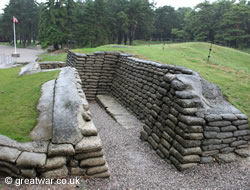
|
In 1922 the Canadian Government was granted a piece of land by France, on which to build a national memorial to her Canadian Forces who had served in the First World War in France and Belgium. This land was at the western end of the Vimy Ridge, a battlefield location where the Canadian Corps had fought and succeeded in pushing the Germans out of their heavily entrenched positions on the ridge in April 1917. The position of the national monument was agreed at the highest point of the ridge at Hill 145. In addition to the ground for the national monument the Canadian Government negotiated with the French Government to ask for an additional tract of the former battlefield so as to preserve it as a memorial park.
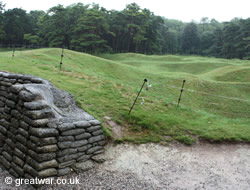
|
The battlefield was cleared and made safe in parts of the designated memorial park, but much of the ground was left untouched in its cratered state. This battlefield had been fought over by French and German troops before the British arrived to take over the sector in early 1916. As a strategic defensive line for the Germans high on the ridge from , they were protecting the view to the east across the Lens-Douai plain and their rear areas and lines of communication. The ground was pock-marked with crater of all sizes, it was entrenched with Front Line and support trenches and tunneled into by both sides.
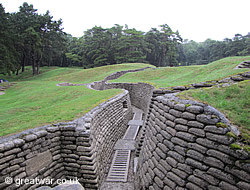
|
During the construction of the Canadian National Vimy Memorial in the 1920s and 1930s the principal Canadian engineer working on the site, Major Unwin Simson, saw that some of the trenches were collapsing due to weather damage. He wondered if they might be preserved in a more permanent way. This would help prevent naturally occuring damage to them by the weather and undergrowth and the number of visitors wishing to walk through them. While he was waiting for the limestone to arrive for the construction of the national memorial on Hill 145, Major Simson gave a job to his workers to rebuild a section of the Allied and the German trenches using sandbags filled with concrete.
The trenches on the Vimy Ridge preserve a short section of the Allied Front Line and the German Front Line, with a few metres of No-Mans-Land in between them. This was the position of the two Front Lines on this part of the Vimy Ridge at the time of the launch of the Allied offensive as the Battles of Arras in April and May 1917. By the end of the Battle of Vimy Ridge (9th - 11th April 1917) the Canadians had pushed forward to the north-east and had pushed the German defenders out of their positions, one small section of which is preserved, to the far side of the ridge and down onto the plain.
Free Guided Visits
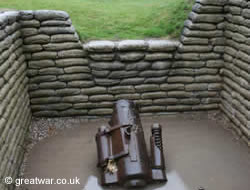
|
From mid January to mid December Canadian university students work for Veterans Affairs Canada as guides for visitors to the Memorial Park. Free guided tours of the preserved trenches and tunnels are available during the opening hours of the Vimy Interpretive Centre, subject to availability. Tours for groups of 10 or more persons can be arranged by reservation (except Mondays and certain holiday days).
For hours of opening and contacts for reservations go to our page at:
Interpretive Centre at Vimy Memorial Park
Access
The part of the Vimy Memorial Park where the preserved trenches are located is not subject to hours of opening, so is accessible by visitors at all hours of the day and every day of the year.
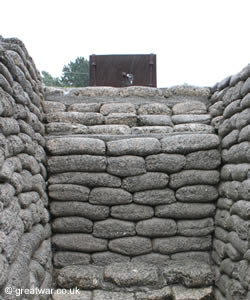
|
Visitors are respectfully asked only to walk on marked pathways throughout the site. As areas of the Memorial Park have never been cleared of battlefield debris, there may be dangers from unexploded munitions if walking beyond the designated access routes. As a site where thousands of Allied and German troops on lost their lives and whose final resting place has never been found, visitors are respectfuly reminded of this.
Wheelchair Access
Paths are provided as an alternative to steps at the Vimy Interpretation Centre and through the centre of the site of the preserved trenches. The trench system itself and the tunnels on the site are not wheelchair accessible.
Parking
There is ample free parking for cars and coaches at the Vimy Memorial Park both at the Canadian National Memorial and at the Interpretive Centre. There is a gate across the entrance to the car park next to the Interpretive Centre. This car park is closed to vehicles at the times when the Interpretive Centre is closed (see opening hours above), but visitors can park outside this gate and walk through to visit the preserved trenches.
Toilets
There are toilets available for visitors next to the Vimy Interpretive Centre, available for visitors during the opening hours of the Interpretive Centre (see below for link).
Preserved Trenches at Vimy Memorial Park Location
Latitude N 50° 22' 17" ; Longitude E 2° 46' 17"
The preserved trenches are located in the Canadian National Vimy Memorial Park. This is located near the village of Vimy about 5 miles (8 kilometres) north-east of Arras on the N17 to Lens. The memorial park is signposted just south of the village of Vimy. The Vimy Interpretive Centre and the location of the Vimy Memorial, the preserved trenches and tunnels are well signposted in the park.
(Note that the aerial satellite image of the Vimy Memorial on the location map includes the scaffolding for the renovation work which was completed in 2006.)
Related Topic

|
Find out more about the Canadian National Memorial, the origins of the design by Walter Allward and other places of interest in the Memorial Park:

